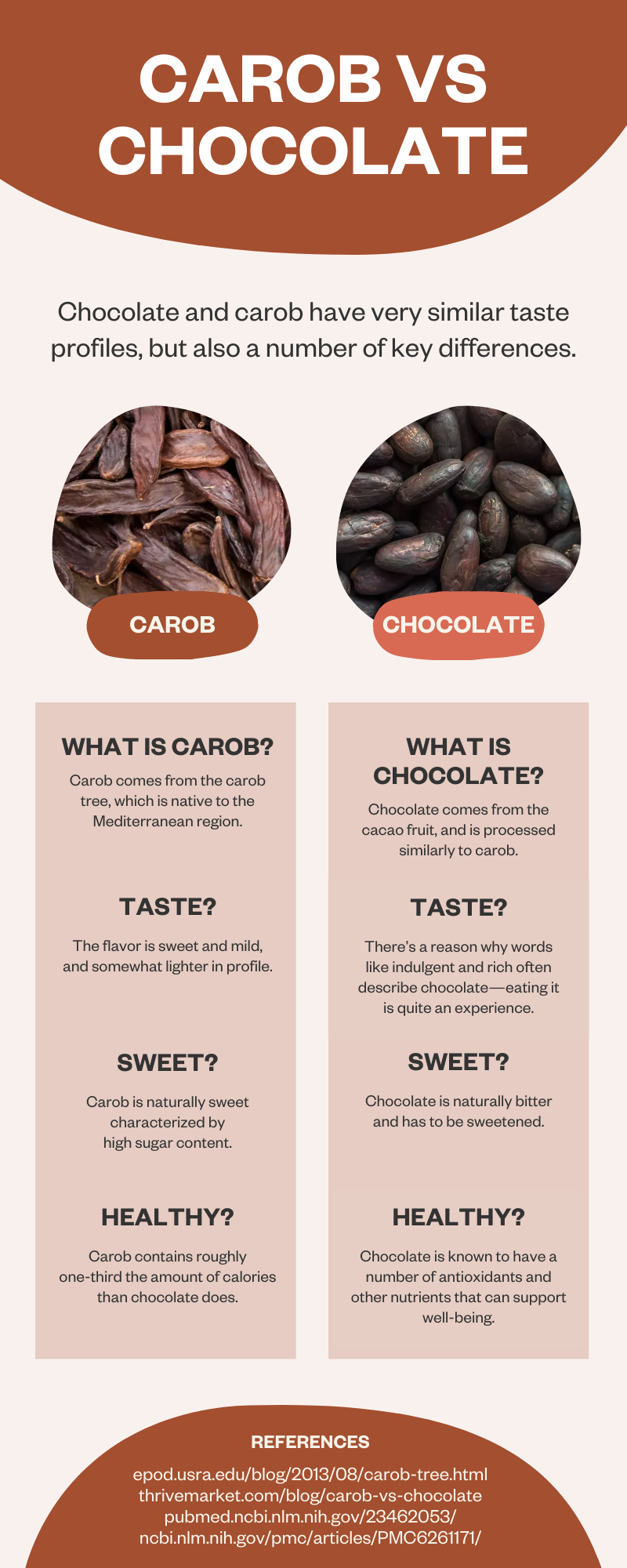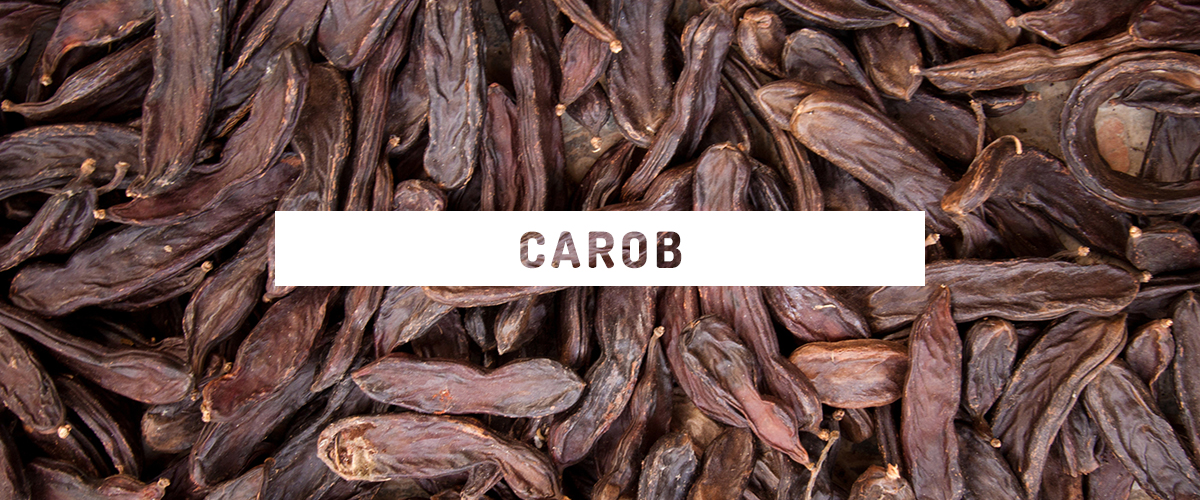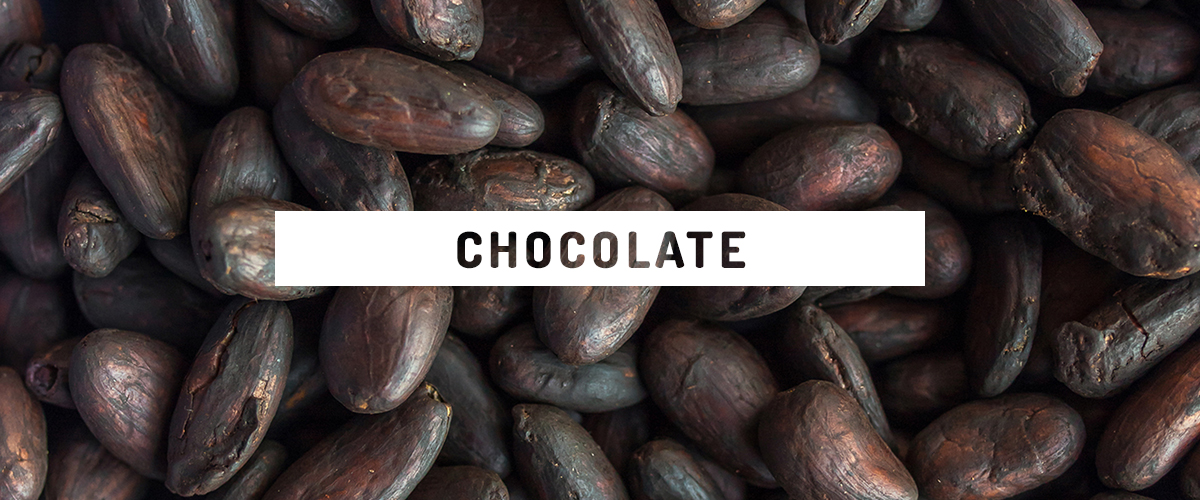Carob vs Chocolate Infographic click here
There’s a reason why words like indulgent and rich often describe chocolate—eating it is quite an experience. And it’s not as bad for you as you might believe.
In fact, chocolate is known to have a number of antioxidants and other nutrients that can support well-being. But the trick is getting the most pure form possible, which means sourcing it straight from the plant and adding no dairy or sugar.
While wholesome chocolate bars are made from pure cacao, there’s also another option known as carob that can be swapped in for chocolate in many instances, from baking to flavoring and beverages.
Chocolate and carob have very similar taste profiles, but also a number of key differences. Here’s a closer look at these two tasty ingredients.
What is Carob?
Carob comes from the carob tree, which is native to the Mediterranean region. It’s been enjoyed for more than 4,000 years, going back to ancient Greece and Italy as well as the Middle East [1] before first being produced in the U.S. in the late 1800s.
To make carobs, the edible pods of the carob tree are harvested and often dried, roasted, and broken down into flour or powder, which is then used to create a variety of different options, which act as a direct alternative to chocolate.
What does carob taste like?
Carob does taste similar to chocolate, though it does have its own unique taste. The flavor is sweet and mild, and somewhat lighter in profile. One of the standout characteristics is that carob is actually naturally sweet whereas cocoa itself is bitter and needs to be sweetened in order for most to enjoy it.
The nutrition of carob
Carob has plenty of vitamins, minerals, and nutrients that can help support wellness [2]:
- 11 grams of fiber per ounce, more than what’s found in chocolate. More fiber is linked to better digestion.
- Roughly 3 times as much calcium as chocolate, which encourages bone health.
- A source of protein, the essential building blocks the human body needs to build resilient cells, muscles, nails, skin, and hair.
- A source of numerous vitamins, including vitamin A and several B vitamins, which respectively support eyesight and metabolism.
- Lower in calories, containing roughly one-third the amount of calories that chocolate does.
The downsides of carob
While taking a look at what’s in carob is important, it’s also worth noting a couple of items that are missing from carob that are often considered bonuses in chocolate.
First, carob contains no caffeine or theobromine. These stimulants can positively impact central nervous system and the cardiovascular system. Additionally, carob contains zero fat, whereas raw cocoa is roughly 50 percent fat content by weight [3]. We now know that healthy fats are essential for the human body.
While various processing steps often remove some of the fats from chocolate, carob is always void of fat: One ounce of carob flour contains zero grams of fat compared to 15 grams in the same amount of chocolate.
Ways to use carob
Carob can be substituted for cocoa powder or chocolate in a one-to-one ratio in recipes; it’s perfect for candies, beverages, and cookies. Some people may also start by swapping out 50 percent of the cocoa powder called for and replacing it with carob, using a 50/50 ratio instead to maintain some of the richer taste of chocolate. Either way, carob can be used practically anywhere that chocolate can be used. Here are a couple of recipe ideas.
Flourless Chocolate Walnut Cookies
These gluten-free cookies bring big nutty flavor along with sweet chocolatey indulgence. It’s easy to swap out the cacao powder with carob powder if desired, and the taste is still just as delicious.
Almond Butter Cups
These little cups put those store-bought, pre-made peanut butter cups to shame. While they can be made with dark chocolate as the recipe calls for, those looking for something different can swap in carob to provide a lighter taste.
Vegan Chocolate Cake with Avocado Frosting
Chocolate desserts are incredibly delicious, but they can be difficult to fit into a vegan lifestyle. This cake breaks the mold, using frosting made from avocado (no, really!) instead of dairy-based ingredients. The cacao powder can be swapped with carob easily.
What is Chocolate?
Chocolate can create cravings that many of us often give in to—but do you know how it’s made?
Chocolate comes from the cacao fruit, and is processed similarly to carob. To do so, the fruit is harvested, dried, and roasted before being ground to powder and turned into chocolate.
What does chocolate taste like?
While carob is naturally sweet, chocolate is naturally bitter. As such, a variety of other ingredients may be added to the manufactured product to increase sweetness, like sugar, dairy, and so on. It’s important to pay attention to this and read the label since these additions can change the overall nature of chocolate’s inherent nutritional content.
The nutrition of chocolate
Chocolate’s overall nutritional content and its health benefits are directly related to how it’s made and what is added to it. Milk, sugar, artificial sweeteners, and other ingredients are frequently used to help cut the natural bitterness found in cocoa, however when you choose options like raw cacao and raw cocoa, there are some health benefits and nutritional factors that make chocolate stand out [4].
- A high level of antioxidants, which can help to protect cells from free radical damage that, if left untamed, can increase the risk of developing certain diseases and some types of cancer.
- Contains serotonin, according to some studies. This hormone can help activate the brain’s pleasure centers and improve overall mood.
- The caffeine content can actually help to stimulate the nervous system and have a positive impact on cognitive function.
- A concentration of flavanols have been heralded by research that shows these compounds could help to improve cardiovascular health and prevent the risk of developing heart disease.
- Iron and copper are present in cacao, which can encourage proper red blood cell function and strengthen bones as well.
- Magnesium and phosphorus are also offered in higher concentrations in cacao. These compounds help improve bone health and promote stronger skeletal structure.
- There’s less carbs and lower sugar content in chocolate; however carob contains more fiber. These nutritional considerations should be considered to determine which is the better choice for a nutritional plan.
Ways to use chocolate
Chocolate is incredibly versatile, used in everything from chili to cake to beverages and beyond. No matter how it’s used, it brings a rich sweetness and unmistakable taste to almost anything. Here are some recipes worth trying to cure a craving.
Paleo Chocolate Lava Cake
Lava cake is one of the most popular desserts on a menu, and the process of making it is well worth the end result. This Paleo-friendly recipe swaps out grain-based flours and uses almond flour instead to delivers a molten, delicious dessert that won’t deter your health goals.
Salted Chocolate S’mores Tart
For an awe-inspiring treat that will impress anyone, this tart truly delivers. It uses fluffy marshmallow topping that sits above dark chocolate ganache and a tasty cookie crust. It’s a perfect example of what dark chocolate can do to really make a dessert pop.
Quinoa Crunch Bars
These tasty bars are made using the darkest of dark chocolate and blending it with popped quinoa for a superfood boost. This crunchy creation takes those rice cereal bars to a whole new level.
Dark Chocolate Popcorn Bars
Take pecans, popcorn, and dark chocolate, and blend together to create a great treat that’s a cross between classic popcorn balls and rice krispy treats. It’s a dessert that’s as fun as it is delicious, with a rich chocolate coating.
Other Questions
Cacao vs. Cocoa Powder
Curious about the difference between these two common chocolate powders? Learn the differences between cacao vs. cocoa powder here.
Pet Safety
While chocolate contains an ingredient that is not safe for our furry friends, carob is safe for dogs & cats to consume [5].
Which is better: carob or chocolate?
Nutritionally speaking, both carob and chocolate offer their own unique benefits and drawbacks. What’s more important to consider is for those that are sensitive to chocolate or are avoiding caffeine or theobromine—in those cases, you want to pay attention to carob.
Additionally, if you are trying to cut out excess fat or sugar you’ll want to look at the overall ingredients of any sweet treat. Even carob, with its lower fat content, may be sweetened artificially. Be sure to always read the ingredient and nutritional content lists of any chocolate or carob product carefully. When pure and raw, both are great for satisfying that sweet tooth while still complementing nutrition.
Nutritional Differences Between Carob and Chocolate
Carob is often used as a chocolate substitute for those who are sensitive to caffeine and theobromine or are looking for a lower-fat option. Delving deeper into the nutritional profiles of carob and chocolate reveals some fascinating contrasts, including the unique benefits of each rich, flavorful food.
Keep in mind that the specific nutritional values can vary based on the type of chocolate (dark, milk, white, etc.) and the processing methods of carob. The values provided are general estimates.
|
Nutrient |
Carob (per 100g) |
Chocolate (per 100g, Dark 70-85% cacao) |
|
Calories |
~222 kcal |
~598 kcal |
|
Protein |
~4.6 g |
~7.8 g |
|
Fat |
~0.7 g |
~43 g |
|
Carbohydrates |
~89 g |
~46 g |
|
Fiber |
~40 g |
~11 g |
|
Sugar |
~49 g |
~24 g |
|
Calcium |
~348 mg |
~73 mg |
|
Iron |
~2.9 mg |
~12 mg |
|
Magnesium |
~54 mg |
~230 mg |
|
Phosphorus |
~79 mg |
~308 mg |
|
Potassium |
~827 mg |
~715 mg |
|
Sodium |
~35 mg |
~20 mg |
|
Caffeine |
None |
~80 mg |
|
Theobromine |
None |
~823 mg |
This comparison is a general guideline, and the actual nutritional content can vary based on the specific product and brand.
- Calories: Chocolate is significantly higher in calories compared to carob.
- Fat: Chocolate, especially dark chocolate, contains a higher amount of fats.
- Carbohydrates and Sugar: Carob has a higher carbohydrate and sugar content.
- Fiber: Carob is an excellent source of dietary fiber.
- Minerals: Chocolate is richer in magnesium, phosphorus, and iron, while carob has more calcium and potassium.
- Caffeine and Theobromine: Chocolate contains caffeine and theobromine, both of which are absent in carob.


